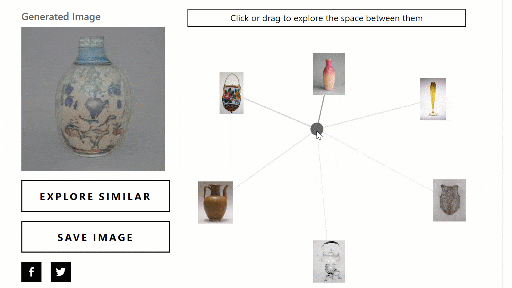Recently, museums are utilizing Artificial Intelligence Technology to engage audiences and personalize visitor experiences. Before doing any further research, it is important to understand what the AI technologies are that are used for audience engagement. How are they implemented into museums? And are there any challenges or problems? The infographic below summarizes the AI subcategories that museums most frequently use, the best practices for each subcategory, the activities that AI are implemented into, and the challenges that technologies could bring.
Among all the subcategories of AI, the three most frequently mentioned sections are Chatbot, Neural Network/Deep Learning, and Machine Learning. The first subcategory is Chatbot, a software robot that interacts with human would connecting with audiences by personalizing the tour and interacting with audiences through intelligent customer service.
Chatbot Dot, the Akron Art Museum's digital tour guide
Secondly, Machine Learning. Machine learning technology could learn, categorize, and make predictions on existing data. The data analysis could be utilized in facial recognition (artworks' style, color, texture, objects recognition), geographic track in social media, and attendance tracking to show audiences' preference for the future exhibition strategy.
Last but not least, based on machine learning, the Neural Network/Deep Learning is also changing the museum experiences. Neural Network/Deep Learning are computing systems that create new data that looks like an existing dataset that is loosely modeled on the human brain. This technology can be used in archival research in museums. For example, a deep learning system can recognize handwriting Latin old documents and make it digital based on its gargantuan memory bank. Besides, the Neural Network can also change the ways for artists to create art. Generative Adversarial Networks(GANs) could be a great example and are already used in the exhibition "Memories of Passerby I" and a prototype "Generist Maps" made by Met, Microsoft, and MIT.
prototype "Generist Maps(Gen Studio)" made by Met, Microsoft, and MIT
To conclude, the uses of AI technologies in audience engagement are dataset organizing and recreating, behavior and attendance analyzing, and experience personalizing. To better understand the implementation of AI in museums. There are several challenges that we need to consider. For example, to what extent does the museum intent to implement the technology? As we all know, most of the exhibitions are curator-designed based on an expert perspective. However, the analysis of audiences' behavior, the utilization of personalized touring, and data prediction will enable museums to put audiences' preferences into consideration. Will the trends impact the prestige of museum experts, or will the exhibition become visitor-generated? Those are the questions we can focus on in future research.
References
“A HALL OF AN INNOVATION: National Soccer Hall of Fame to use facial recognition for fan
experience.” August 21, 2018.
“AI: The Rise Of A New Art Movement.” Obvious Art. Last modified February 14, 2018.
http://obvious-art.com/blog-post.html.
Anstey, Tom. “Barnes Foundation uses intelligent machines to offer new ways of interpreting art
collections.” Attractions Management. July 17, 2018.
https://www.attractionsmanagement.com/index.cfm?pagetype=news&codeID=338394.
“ARTIFICIAL INTELLIGENCE Technology Landscape.” Callaghan Innovation. Accessed
March 9, 2020.
Bertagnoli, Lisa. “Art Institute uses data to give visitors what they want.” Chicago Business.
May 18, 2018.
Chen, Lin. "Online to Offline: Artificial Intelligence helps to design a personalized museum in
the digital era." Pratt. March 5, 2019.
Falk, John H. (John Howard), and Lynn D. Dierking. Learning from Museums : Visitor
Experiences and the Making of Meaning Walnut Creek. CA: AltaMira Press, 2000.
“GenStudio.” GitHub. Last modified December 16, 2019.
https://github.com/microsoft/GenStudio.
“Homepage.” Gen Studio. Accessed March 9, 2020.
“Homepage." Google Arts and Culture. Accessed March 9, 2020.
https://artsandculture.google.com/.
“Homepage." Knight Foundation. Accessed March 9, 2020.
“Identifying art through machine learning— A project with Google Arts & Culture Lab.”
MoMA. Accessed March 9, 2020.
https://www.moma.org/calendar/exhibitions/history/identifying-art.
Kean, Sam. “Artificial Intelligence Is Cracking Open the Vatican's Secret Archives.” The
Atlantic. April 30, 2018.
Kinsella, Eileen. “The Met Museum Envisions a Future Where Artificial Intelligence Helps You
Find #Art Posts for Your Instagram.” Artnet News. February 5, 2019.
https://news.artnet.com/art-world/the-met-ai-1456774.
Lee, Dami. “Deepfake Salvador Dalí takes selfies with museum visitors.” The Verge. March 10,
2019.
https://www.theverge.com/2019/5/10/18540953/salvador-dali-lives-deepfake-museum.
Litt, Steven. “Dot, the new Akron Art Museum chatbot, wants to get you talking about art and
life.” Last modified Jan 30, 2019.
https://www.cleveland.com/arts/2018/08/dot_the_new_akron_art_museum_c.html.
“Museum & New Intelligence— A primer for attendees.” American Alliance of Museums.
Accessed March 9, 2020.
Sikorsky, Michael, and Rita Gunther McGrath. “Bots Are about to Get Better at Customer
Support than Humans.” WIRED UK. December 19, 2017.
https://www.wired.co.uk/article/message-bot-customer-care.
Smith, Ryan P. “How Artificial Intelligence Could Revolutionize Archival Museum Research.”
Smithsonian Magazine. November 3, 2017.
Soracco, Anna. “How Gen Studio was created for The Met using Microsoft AI.” Channel9.
March 4, 2019.
https://channel9.msdn.com/Shows/AI-Show/Gen-Studio.
Styx, Lauren. “How are museums using artificial intelligence, and is AI the future of museums?”
Museum Next. March 28, 2019.
https://www.museumnext.com/article/artificial-intelligence-and-the-future-of-museums/.
Tallon, Loic. “Sparking Global Connections to Art through Open Data and Artificial
Intelligence.” Met Museum. February 4, 2019.
Vermeeren, Arnold., Licia. Calvi, and Amalia. Sabiescu. Museum Experience Design Crowds.
Ecosystems and Novel Technologies 1st ed. 2018. Cham: Springer International Publishing, 2018.
Vincent, James. “A never-ending stream of AI art goes up for auction.” The Verge. March 5,
2019.
https://www.theverge.com/2019/3/5/18251267/ai-art-gans-mario-klingemann-auction-sothebys-technology.



